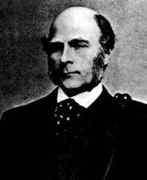Person: Galton, Francis

Francis Galton was an English polymath, explorer, anthropologist and statistician. He invented the concept of "regression to the mean" and is famous as "the father of eugenics".
Mathematical Profile (Excerpt):
- Galton's parents, both from important Quaker families, might have served as excellent examples of his ideas on hereditary genius.
- Francis attended a number of small schools in the Birmingham area before entering King Edward's School in Birmingham in 1836.
- On his return to England Galton entered Trinity College, Cambridge, to study medicine in the autumn of 1840.
- No longer needing to think in terms of a career since he was financially secure, Galton decided to follow his passion for travel and made a trip with friends up the Nile to Khartoum.
- (In fact the source of the Nile was not discovered to be Lake Victoria until 1858.) Galton also visited the Holy Land and Syria before deciding that he would devote himself to sport, which he did for five years from 1845 at 1850.
- Deciding that sport did not suit him, Galton began to plan more ambitious travels.
- Galton aimed to find a passage to the lake from the south west, and with this plan in mind his expedition landed in Walvis Bay (in present day Namibia).
- Walvis Bay to Ngami Lake is around 550 miles and, despite two attempts to reach the lake, Galton's party failed in both attempts.
- When Galton returned to England he published an account of his journeys in Tropical South Africa (1953).
- Perhaps it was the publication of Charles Darwin's Origin of the species in 1859 which marked a change in direction of Galton's interests.
- Galton was the cousin of Charles Darwin, so perhaps it was natural that he should be one of the first to be converted by the book.
- Let us examine Galton's contribution to statistics in a little more detail.
- Galton realised that the off-spring tended to revert towards the mean size.
- In 1884-85 the International Health Exhibition was held and in connection with this Galton set up a laboratory to measure human statistics.
- Galton now made further progress with the ideas he had already formed concerning regression.
- In 1889 Galton published Natural inheritance in which presented as summary of the work he had done on correlation and regression.
- Among the data which Galton collected in his laboratory were impressions of fingers.
- The Galton-Henry system of fingerprint classification was published in June 1900, and began to be used at Scotland Yard in 1901 as an identifier on criminal records.
- As well as being an indefatigable investigator of human intelligence, Galton made important contributions to the fields of meteorology, anthropometry, and physical anthropology.
Born 16 February 1822, Sparkbrook (near Birmingham), England. Died 17 January 1911, Grayshott House, Haslemere, Surrey, England.
View full biography at MacTutor
Tags relevant for this person:
Origin England, Statistics
Thank you to the contributors under CC BY-SA 4.0! 

- Github:
-

- non-Github:
- @J-J-O'Connor
- @E-F-Robertson
References
Adapted from other CC BY-SA 4.0 Sources:
- O’Connor, John J; Robertson, Edmund F: MacTutor History of Mathematics Archive
